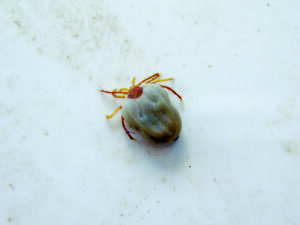Ticks are common in all areas of North Carolina. They are more likely to live in wooded areas or high grassy areas. Ticks are blood sucking arthropods which makes them kin to the spider. Ticks can cause disease in humans and animals. Ticks can cause several different diseases in humans but the ones heard about most often are Lyme disease and Rocky Mountain Spotted Fever.
 There are several different tick species found in North Carolina. Each tick is known for causing different diseases. The American Dog tick is credited for Rocky Mountain Spotted Fever and Tularemia. The black legged tick has been known to causes anaplasmosis, bebesiosis, and Lyme disease. The brown dog tick can carry Rocky Mountain Spotted Fever. The Lonestar trick carries ehrlichiosis, tularemia and STARI(Southern Tick Associated Rash Illness) . Persons should not be expected to know the type of tick they may have found and removed from themselves or their pet.
There are several different tick species found in North Carolina. Each tick is known for causing different diseases. The American Dog tick is credited for Rocky Mountain Spotted Fever and Tularemia. The black legged tick has been known to causes anaplasmosis, bebesiosis, and Lyme disease. The brown dog tick can carry Rocky Mountain Spotted Fever. The Lonestar trick carries ehrlichiosis, tularemia and STARI(Southern Tick Associated Rash Illness) . Persons should not be expected to know the type of tick they may have found and removed from themselves or their pet.
Ticks go through four stages in their life cycle. They must eat blood at every stage to survive. They prefer different hosts at each stage. Many ticks die because they cannot find another host to feed on. Ticks can feed on mammals, amphibians, reptiles and birds. Ticks cannot fly or jump. They find their host and grab on. Ticks then prepare to feed. They make a cut in the skin and insert their feeding tube. Some ticks have feeding tubes that are jagged on the end to hold to the skin. Others secrete a substance that cements the tube in place while they feed. Some ticks secrete an anesthetic so the host cannot feel the bite. Ticks feed slowly on the hosts’ blood for several days. Small amounts of saliva may be secreted from the tick as it feeds. This is how ticks spread disease from one host to another.
Humans should try to protect themselves from ticks. Prevention is the key. There are several ways to minimize the chance of being bit by a tick. First, wear light colored clothing. Avoid heavily weeded or brushy areas if possible. Wear tick repellant. Tick repellant can be applied to exposed skin to anyone over 2 months of age. Use a product that contains at least 20 percent deet. Apply the repellent only to exposed skin. Clothing can be purchased or treated with a product called permethrin. Do not purchase lotions that serve as sunscreens and tick repellents. Sunscreens have to be reapplied more often and are prone to being washed or sweated off when outdoors. The properties in deet are not likely to be washed away, and therefore individuals do not want to be over treated.
Shower or bathe as soon as you can when you have been outdoors in possible tick exposure areas. Examine all over your body for ticks. If you find a tick, remove it by grasping the body of the tick with tweezers. Put one side of the tweezers under the tick, next to the skin and the other on top. Lift straight up. Assure that the tick is intact. If the head /mouth remained, try to remove it. If unsuccessful, wash the area well with soap and water. Write down in a safe place the date the tick was removed. Should the person who had the tick bite become sick in the next 1-4 weeks, tell the doctor the date of the tick bite.
Most tick borne illnesses are similar. Fever, muscle aches and rash. There are many illness associated with tick bites. It is very important a person seek medical attention if they feel they may have tick borne illness. Some illness can be fatal. Prevention is the key. Wear repellent with deet. Examine each other when returning from the outdoors. Check your animals and get ticks off them as well.
Info: Cherokee Community Health 554 6882, or visit https://epi.publichealth.nc.gov/cd/diseases/ticks.html, https://www.cdc.gov/ticks/diseases/
– Cherokee Community Health






